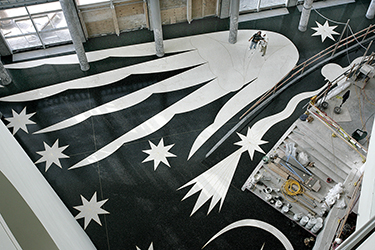|
Subscribe / Renew |
|
|
Contact Us |
|
| ► Subscribe to our Free Weekly Newsletter | |
| home | Welcome, sign in or click here to subscribe. | login |
Construction
| |

September 7, 2017
Good old terrazzo gets rediscovered (again) by architects and designers
Associated Press
Many of us think of terrazzo — a composite including chips of various stones and glass — as a utilitarian flooring material, something you see in lobbies or hallways.
But the centuries-old material is being rediscovered by architects and designers who are adapting its distinctive patterns for all kinds of surfaces, including furniture, and other creative uses.
Terrazzo was one of the first sustainably produced materials, says Venice-based interior designer and architect Elisabetta Rizzato.
“Craftspeople used waste materials — for instance, local Venetian stone off-cuts and chips from the construction of palazzos — to make decorative mosaic-like floors,” she says. “Eventually, they began introducing glass, metals and even concrete, all while consistently using local-material waste.”
The raw materials may have had humble origins, but Rizzato says terrazzo was popular with Renaissance aristocrats.
“It was the best flooring option (for palaces) because it was flexible and could adapt to structural failures of the wooden beams,” she says.
Terrazzo also became the darling of midcentury architects, who appreciated its elegant minimalism.
“Look at Frank Lloyd Wright's terrazzo floors in the Guggenheim Museum,” says Paul Makovsky, vice president of design for the New York architecture and design magazine Metropolis. “Since it was built in 1959, over a million people walk on that floor each year, and it looks as good as new.”
Makovsky associates Art Deco terrazzo with “the construction of public buildings that were beautiful and meant to last. You know where you'll see surprisingly beautiful terrazzo floors? The Hoover Dam.”
Los Angeles architect Dan Brunn is also a fan. “Unless a client is against it, I use it,” he says. “I love that it's durable and can cover interior and exterior expanses, which really helps create a seamless indoor-outdoor connection.”
Miami architect Michael Wolk added terrazzo-topped patio tables of his re-design of the Atlantikos restaurant at Florida's St. Regis Bal Harbor Resort. Wolk also ran terrazzo throughout a spacious, Zen-like master bath in the Palm Beach area; the material looks luxe, yet has a softer, more welcoming appearance and feel than marble.
Easy-to-use options now include precast terrazzo made with durable resins.
London designer Max Lamb has created a precast terrazzo for Dzek called Marmoreal that can go on floors, walls and countertops. Colorful marble aggregate is embedded in white or black resin; the light version looks like nougat candy, while the dark one evokes a night sky.
Large- and small-format slabs and tiles like Atlas Concorde's Marvel Gems collection and Ornamenta's Stile Libero come in earthy and versatile palettes that mimic traditional terrazzo mixtures.
If you want to bring terrazzo into a space on a smaller scale, there are lots of creative new options, Makovsky says. For example, he says, Los Angeles studio Besler and Sons have designed fun “Props” made of terrazzo that blend colored glass, marble chips and cement. The simple geo shapes, made with black, white and red aggregates in white or strawberry red matrix, can be used as bookends, doorstops, paperweights and serving platters.
From Brodie Neill, a London-based industrial designer, comes the kaleidoscopic blue and green Gyro table, made from what he calls “ocean terrazzo” — 70 percent recycled plastic waste from the sea.
West Elm's contemporary, hexagonal cement planter with a faux-terrazzo pattern could house indoor or outdoor greenery. West Elm also carries Roar & Rabbit's curvy, terrazzo-based table lamp, and a set of brass-edged coasters.
Deny Designs has a collection of small furniture, textiles and accents in a pattern called Sweet Terrazzo, by Emanuela Carratoni.
Wallpaper and vinyl tile make affordable substitutes for the real thing, suggests Makovsky. Both www.spoonflower.comand www.muralswallpaper.com have terrazzo-patterned wall coverings.
Johnsonite's Gemstone vinyl flooring collection comes in evocative hues like Sunlight, Beach Glass and Silver Moon.
Previous columns:
- Tiny home village in Eugene will have rent-to-own units, some even with bathtubs, 08-31-2017
- $5.2M Forest Service project would rebuild smokejumper base at Methow Valley Airport, 08-24-2017
- Students have renovated five buildings for Sitka Fine Arts Camp in Alaska, 08-17-2017
- Seattle makes another go at public potties, with toilets for Ballard and the U District, 08-10-2017
- LA is already prepping for the 2028 Olympics, but will some venues be out of date by then?, 08-03-2017
- New rules for outdoor air systems will mean big changes for architects and engineers, 07-27-2017
- Cranes crowd Portland skyline as building boom continues; 10,000 construction workers needed, 07-20-2017
- 140-year-old bell, other artifacts on display at new fire station in Albany, 07-13-2017



